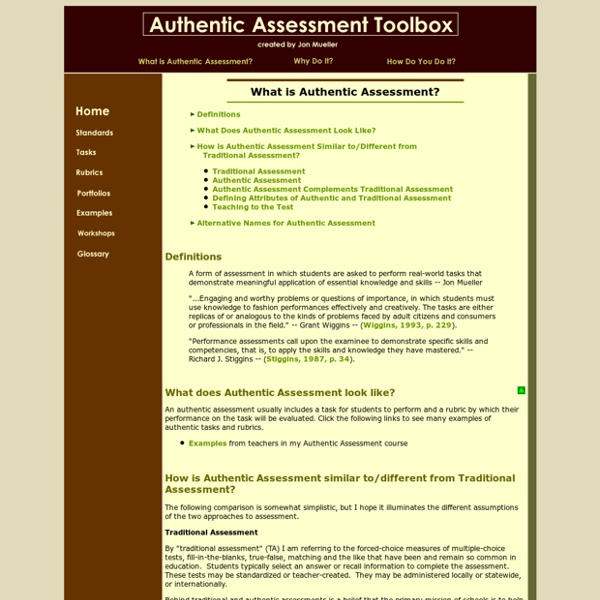Bloom's Taxonomy
Looking for Strategies and Activities? Click Here! What is Bloom’s Taxonomy?
The One-Right-Answer-Mentality (Part Two)
Formative and authentic assessments as creativity builders At the risk of grossly oversimplifying the wonderful work by Benjamin Bloom, Robert Marzano, Paul Black, Dylan William and other scholars, I would simply say that summative assessments, especially standardized tests are about ranking students (and their schools, teachers, principals, superintendents, school boards, departments of education, ad infinitum). Formative assessments are tools designed to help students grow. Formative assessments provide feedback to the teacher in real time so that they can, as Madeline Hunter used to say “monitor and adjust.” They let the teacher know where a student is proficient and where that student needs more help or practice. Unlike a summative assessment, no student is labeled a permanent C student or not performing at grade level.
Students Self-Assess For Mastery - Work in Progress
You might be wondering if students are capable of grading themselves after a year worth of work. You may be asking if they can objectively review their growth and then take all of their understanding of mastery and parlay it into a letter grade that suits the old system. Perhaps a year or two ago, I too would scoff at the idea of students being able to really reflect on their abilities and determine an honest level of mastery that would yield an appropriate grade. However, after a year of breaking down the traditional mindset, it was time to put the full power into my students' hands.
University Strategies
American Association for Higher Education ASSESSMENT FORUM 9 Principles of Good Practice for Assessing Student Learning The assessment of student learning begins with educational values. Assessment is not an end in itself but a vehicle for educational improvement. Its effective practice, then, begins with and enacts a vision of the kinds of learning we most value for students and strive to help them achieve. Educational values should drive not only what we choose to assess but also how we do so.
Education 320: Teaching PE & Health, Elementary Education
This course was developed to satisfy the California Commission of Teaching credentialing requirements for teacher candidates. The class provides opportunities for candidates to learn how to teach the basic and essential fundamentals of physical education for K-6th grade students. The central knowledge is about children’s motor skill development along with the emotional and social aspects related to physical activity. Teachers will learn the key aspects of a physical education lesson, which include a warm-up activity, the lesson plan (skill development and game applications), and closure. As a total lesson, at least half the time is spent in moderate to vigorous activity. The course also addresses classroom management techniques, safety and liability, kinesiology, and instructional techniques.
Student Self-Assessment Practices That Work (Opinion)
Understanding how we learn best is one of the keys to growth as human beings. This essential metacognitive skill is not innate and must be modeled and taught in school starting as early as possible. The way it looks for different age groups will be different, obviously as younger students are not always cognitively ready to do this kind of thinking. However with the right scaffolds in place, reflection and self-assessment can be a rich way to extend the depth of independent learning and also aid in informing the teacher about valuable data around growth and understanding. As we put more and more of the control into student hands, it’s not enough to just tell them to reflect or self-assess; it is imperative that we give them tools to do these practices well and then offer many opportunities to practice and get better at it.
We MUST Help Students Learn to Self-Advocate - Work in Progress
"Ms. Sackstein, I can't do this! I need help." "Ms. Sackstein, can you look at this paper and tell me if it's good?"
Assessment - Teaching & Learning - University of Tasmania, Australia
Welcome to good assessment practices at UTAS This site provides support to academic staff in good assessment practices. A focus of the site is to assist academic staff in the implementation of criterion-referenced assessment (CRA), as endorsed by University Senate in 2007. The content of this site (except for 'Moderation of results in a CRA process') was developed by Moira Cordiner (TILT, UTAS) between 2009 and 2011.
Project-Based Learning Research Review
Editor's Note: This article was originally written by Vanessa Vega, with subsequent updates made by the Edutopia staff. Studies have proven that when implemented well, project-based learning (PBL) can increase retention of content and improve students' attitudes towards learning, among other benefits. Edutopia's PBL research review explores the vast body of research on the topic and helps make sense of the results. In this series of five articles, learn how researchers define project-based learning, review some of the possible learning outcomes, get our recommendations of evidence-based components for successful PBL, learn about best practices across disciplines, find tips for avoiding pitfalls when implementing PBL programs, and dig in to a comprehensive annotated bibliography with links to all the studies and reports cited in these pages.



